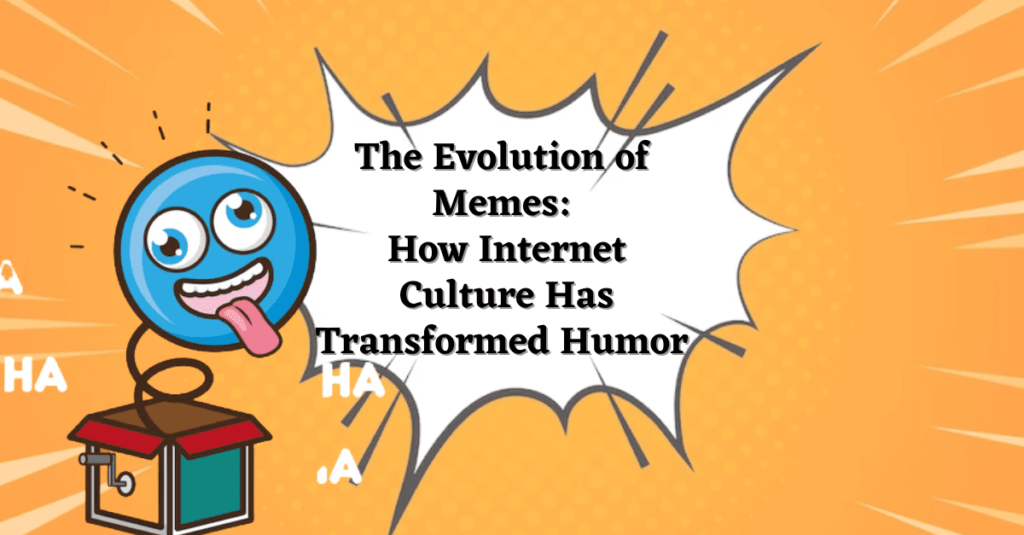Introduction
The internet has transformed the way we communicate and share information, and the evolution of memes is one of the most fascinating and entertaining parts of this digital age. Memes have permeated online culture and have become an intrinsic part of our daily lives. In this blog, we will look at the history of memes and how they have changed humor in the digital age.
What are memes?
Before we get into the evolution of memes, let’s define them first. A meme is a cultural symbol or concept that spreads from person to person, frequently through imitation or replication. This can be anything from a catchphrase to a dance motion to a fashion statement. Memes have taken on new meaning in the digital era. These are frequently amusing photographs, movies, or text that are shared on social media and other websites.
The term “meme” was first used in 1976 by biologist Richard Dawkins in his book “The Selfish Gene.” He described a meme as “a cultural idea, activity, or style that spreads from person to person.” This notion is still valid today, but the internet has transformed the concept of memes into something altogether different.
The early days of internet memes
Memes on the internet first appeared in the 1990s, when the internet was still in its infancy. Memes were largely text-based and circulated via email and online message boards at the time. The “Dancing Baby,” a 3D cartoon of a newborn doing the cha-cha that went viral in the late 1990s, was one of the most renowned early memes.
The development of social media platforms such as Myspace and Facebook in the early 2000s ushered in a new era of memes. This was the birth of the image-based meme, in which images were matched with clever captions or overlaid with text to produce amusing material. The “I Can Has Cheezburger” meme, which featured photographs of cats with misspelled captions in broken English, was one of the most successful early image-based memes.
The modern era of memes
With the rise of social media sites such as Twitter, Instagram, and Reddit in the mid-2000s, the contemporary era of memes began. These sites made it easier for users to share and create memes than ever before, and they quickly became a part of internet culture.
The ability of modern memes to be constantly remixed and repurposed is one of their defining traits. Memes can be taken out of context and used in novel and unexpected ways. The “Distracted Boyfriend” meme, for example, which depicts a man staring at another woman as his girlfriend looks on in disgust, has been recycled innumerable times to create fresh and amusing scenarios.
Another distinguishing feature of current memes is their capacity to propagate and develop swiftly. Memes may go viral in a matter of hours and take on a life of their own when they are shared and remixed by people all over the world. This has resulted in the development of internet subcultures centered on specific memes, such as the “Pepe the Frog” meme, which was appropriated by far-right groups and turned into a symbol of hatred.
How memes have evolved
Memes have changed dramatically since their inception. Memes were generally simple and text-based in the early days of the internet. Memes, on the other hand, have become increasingly intricate and visually appealing as technology has improved. Today’s memes frequently feature images, videos, and animations, as well as witty words or clever jokes.
The rise of social media has been one of the most significant revolutions in the world of memes. Memes are now easier to share and produce than ever before because of platforms like Facebook, Twitter, and Instagram. Memes have gained in popularity alongside these platforms. Memes are becoming a common feature of social media culture, used to express everything from political beliefs to personal humor.
The advent of internet culture is another aspect that has contributed to the evolution of memes. Internet culture is a subculture that has developed in response to the widespread use of the internet. Online gaming, social media, and memes are examples. Memes have gained in popularity alongside internet culture. Memes are frequently used today to express insider jokes and references that only internet culture users would understand.
How memes have transformed humor
Memes have altered humor in a variety of ways. To begin with, they have made humor more accessible. Anyone with an internet connection may create or spread a meme, which means that comedians and professional writers are no longer the sole purveyors of humor.
Memes have also made humor more approachable. Previously, gatekeepers such as television executives and publishers dominated the world of humor. Nevertheless, with the rise of memes, anyone can create something amusing and share it with the rest of the world. As a result, the humor landscape has become more diverse and inclusive, with voices from all walks of life contributing to the conversation.
Perhaps most importantly, memes have increased the globalization of humor. Historically, comedy was mostly regional. What works in one culture may not work in another. Yet, memes are universal. They use visual language and simple principles that anyone, regardless of background or cultural identity, can understand. As a result, the globe has become more interconnected and globalized, with comedy being shared and appreciated across boundaries.
Conclusion
Memes are more than just amusing images found on the internet. They are a cultural phenomena that has changed the way we connect online and how we laugh. Memes have developed from basic text-based gags to elaborate animations and movies, becoming a mainstay of social media culture. Memes will rise in popularity as internet culture grows. Whether you love or despise memes, there is no disputing their influence on how we laugh and communicate online.
